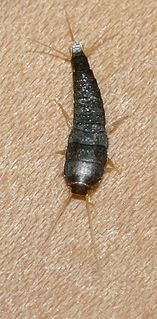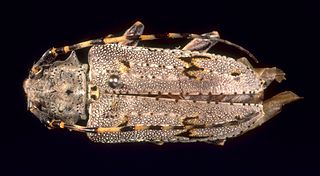The International Code of Zoological Nomenclature (ICZN) is a widely accepted convention in zoology that rules the formal scientific naming of organisms treated as animals. It is also informally known as the ICZN Code, for its publisher, the International Commission on Zoological Nomenclature. The rules principally regulate:

Sphaerius is a genus of beetles, comprising 23 species, which are the only living members of the family Sphaeriusidae. They are typically found along the edges of streams and rivers, where they feed on algae; they occur on all continents except Antarctica. Three species occur in the United States.

Lepisma is a genus of primitive insects in the order Zygentoma and the family Lepismatidae.

The International Commission on Zoological Nomenclature (ICZN) is an organization dedicated to "achieving stability and sense in the scientific naming of animals". Founded in 1895, it currently comprises 24 commissioners from 18 countries.
A tautonym is a scientific name of a species in which both parts of the name have the same spelling, for example, Rattus rattus. The first part of the name is the name of the genus and the second part is referred to as the specific epithet in the International Code of Nomenclature for algae, fungi, and plants and the specific name in the International Code of Zoological Nomenclature.
In biology, within the science of scientific nomenclature, i.e. the naming of organisms, an orthographical variant in botany or an orthographic error in zoology, is a spelling mistake, typing mistake or writing mistake within a scientific publication that resulted in a somewhat different name being accidentally used for an already-named organism. The rules that govern what to do when this happens are laid out in the relevant codes of nomenclature.
In zoological nomenclature, the valid name of a taxon is the sole correct scientific name. The valid name should be used for that taxon, instead of any other name that may currently be being used, or may previously have been used. A name is valid when, and only when, it is in harmony with all the relevant rules listed in the International Code of Zoological Nomenclature (ICZN). A valid name is the correct zoological name of a taxon.
A conserved name or nomen conservandum is a scientific name that has specific nomenclatural protection. That is, the name is retained, even though it violates one or more rules which would otherwise prevent it from being legitimate. Nomen conservandum is a Latin term, meaning "a name to be conserved". The terms are often used interchangeably, such as by the International Code of Nomenclature for Algae, Fungi, and Plants (ICN), while the International Code of Zoological Nomenclature favours the term "conserved name".

Aporrhais pespelecani, common name the "pelican's foot", is a species of sea snail, a marine gastropod mollusk in the family Aporrhaidae.
Sthenognatha is a genus of tiger moths in the family Erebidae. There is some confusion surrounding the subsequent spelling by Rogenhofer, 1875, as Stenognatha; this spelling was used by many authors prior to 1980, and under ICZN Article 33.3.1 it may need to be preserved, though many authors after 1980 have reverted to Sthenognatha (e.g.).
Tricholepisma is a genus of primitive insects belonging to the family Lepismatidae.

ZooBank is an open access website intended to be the official International Commission on Zoological Nomenclature (ICZN) registry of zoological nomenclature. Any nomenclatural acts need to be registered with ZooBank to be "officially" recognized by the ICZN Code of Nomenclature.
AnimalBase is a project brought to life in 2004 and is maintained by the University of Göttingen, Germany. The goal of the AnimalBase project is to digitize early zoological literature, provide copyright-free open access to zoological works, and provide manually verified lists of names of zoological genera and species as a free resource for the public. AnimalBase contributed to opening up the classical taxonomic literature, which is considered as useful because access to early literature can be difficult for researchers who need the old sources for their taxonomic research.
In zoological nomenclature, emendations are alterations made to the spelling of taxon names. In bacteriological nomenclature, emendations are made to the circumscription of a taxon.

Aegomorphus morrisi is a species of beetle in the family Cerambycidae. It was described by Uhler in 1855. The species name is often misspelled as morrisii (e.g.) but this spelling is not in prevailing usage and the original spelling is therefore valid under ICZN Article 33.4.

Aristobia horridula is a species of beetle in the family Cerambycidae. It was described by Frederick William Hope in 1831, originally under the genus Lamia. It is known from Myanmar, Laos, Taiwan, China, Thailand, and Vietnam.
Aristobia quadrifasciata is a species of beetle in the family Cerambycidae. It was described by Per Olof Christopher Aurivillius in 1916 and is known from Sumatra and Malaysia.

Aristobia umbrosa is a species of beetle in the family Cerambycidae. It was described by James Thomson in 1865, originally under the genus Celosterna. It is known from Malaysia, Borneo and Sumatra. It contains the varietas Aristobia umbrosa var. variefasciata.

Aristobia reticulator is a species of beetle in the family Cerambycidae. It is known from Bhutan, Myanmar, India, China, Laos, Bangladesh, Thailand, and Vietnam. It feeds on Prunus persica, Liquidambar formosana, Quercus acutissima, Prunus salicina, and Nephelium mutabile. Many references list the name as Aristobia testudo, but this name, though published earlier, is unavailable under the ICZN, primarily in that Johann Eusebius Voet's 1778 work giving the name testudo fails to fulfill the requirement in ICZN Article 11.4 that a work must be consistently binominal; none of Voet's 1778 names, including testudo, are available.
Spintharus rallorum is a species of comb-footed spider in the family Theridiidae. It is found in Puerto Rico and Saint Kitts and Nevis. It is one of 15 new species described in 2018. The authors spelt the name as Spintharus ralli, but noted that it honoured the "grandparents of the first author of the species." As the name refers to more than one person, the World Spider Catalog changed it from the Latin genitive singular to the genitive plural.









